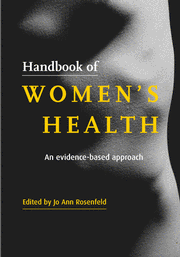Book contents
- Frontmatter
- Contents
- List of contributors
- Common abbreviations used in the text
- Normal blood values in women and during pregnancy
- Introduction
- 1 Singular health care of women
- Preventive care
- Psychosocial health
- 8 Psychosocial health of well women through the life cycle
- Sexuality
- Genitourinary medicine
- Breast disorders
- Psychological disorders
- Common medical problems
- Index
8 - Psychosocial health of well women through the life cycle
Published online by Cambridge University Press: 28 October 2009
- Frontmatter
- Contents
- List of contributors
- Common abbreviations used in the text
- Normal blood values in women and during pregnancy
- Introduction
- 1 Singular health care of women
- Preventive care
- Psychosocial health
- 8 Psychosocial health of well women through the life cycle
- Sexuality
- Genitourinary medicine
- Breast disorders
- Psychological disorders
- Common medical problems
- Index
Summary
Primary care providers are uniquely able to assess the psychosocial health of women. While most individuals who seek care are “patients” — those who require or request care for specific problems — women are more frequently seen when they are well. Whether for Pap smears, prenatal care, or general physical examinations, family practitioners will more likely encounter healthy women throughout their lives. Psychosocial health is the substrate from which a woman adapts to the complex world that is her life. As such, whether seen in illness or in health, the primary care provider always has an abiding interest in the psychosocial state in which the individual presents herself.
Definitions
Psychosocial health is not easily defined. For purposes of this chapter, a few broad deinitions will be useful.
“Psychosocial” refers generally to the psychological status of an individual within the context of their social environment.
“Well woman” refers both to the absence of disease and the experience of health. This implies a broad definition of health to include cognitive, emotional, physical, psychological, spiritual, and environmental factors.
Assessment of, and screening for, psychosocial health has an intangible quality that is deeply intertwined with the provider-patient relationship. The life and clinical experience of the provider has a profound impact on decisions about the value, methodology, and approach toward assessment of psychosocial health. Some providers feel this is not an essential role for the clinician and others see the relationship as a potentially powerful tool toward understanding the individual, enhancing the relationship with the patient and potentially favorably influencing her future health.
…
- Type
- Chapter
- Information
- Handbook of Women's HealthAn Evidence-Based Approach, pp. 111 - 128Publisher: Cambridge University PressPrint publication year: 2001



